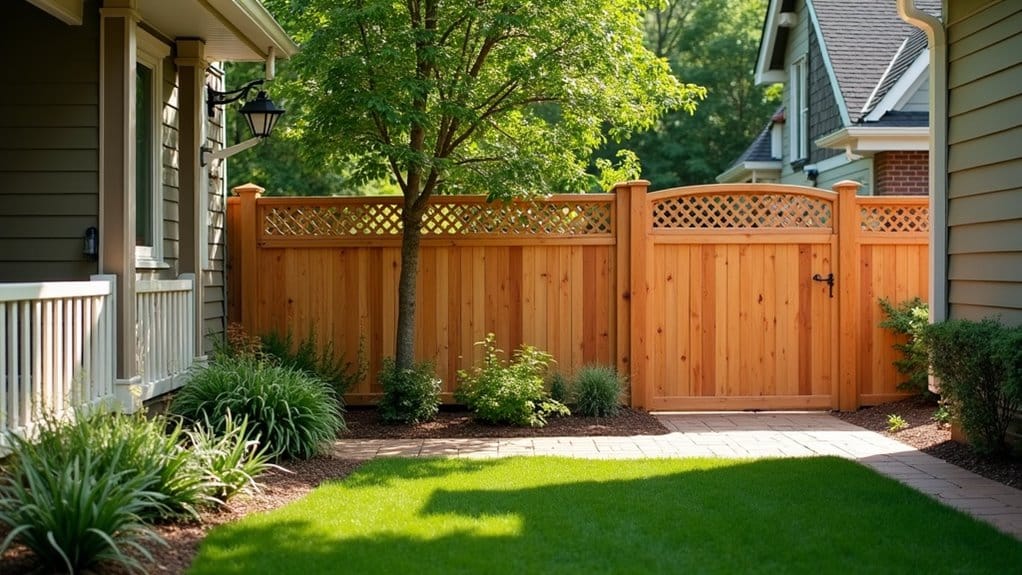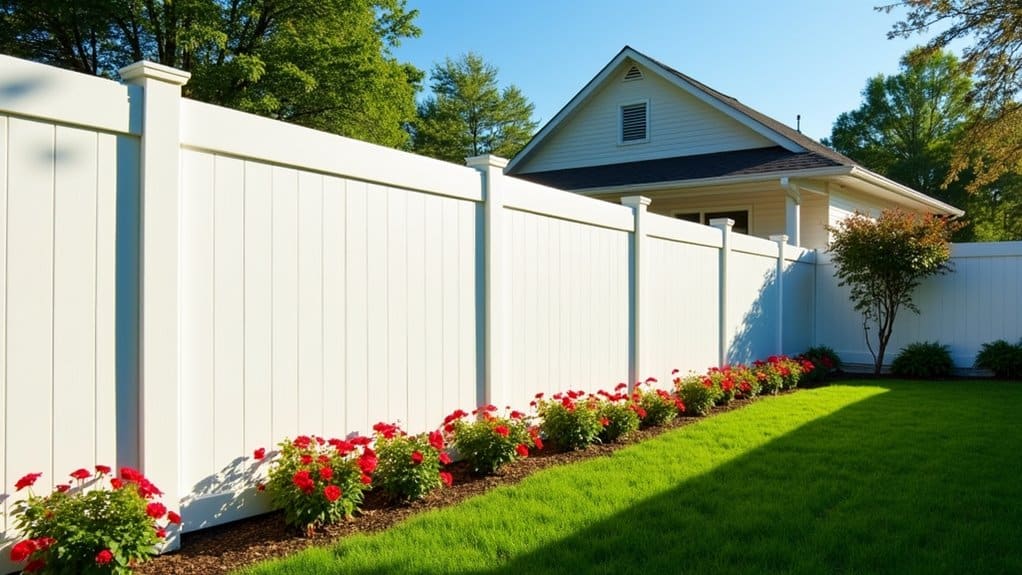To repair farm fences after weather damage, start by inspecting the entire fence for loose boards, rust, or leaning posts. Gather your tools: hammers, saws, and safety gear. For wooden fences, replace damaged panels and use weather-resistant sealants. For vinyl fences, a repair kit works wonders. Stabilize metal fences by removing rust and tightening posts. Remember to maintain your fence regularly to keep it in good shape. More tips will follow shortly.
Key Takeaways
- Inspect your entire fence for loose boards, leaning sections, and other damage caused by the weather.
- Gather tools like hammers and saws, and have safety gear ready, along with materials for repairs, to streamline the process.
- Fix wooden fences by replacing damaged panels, securing unstable posts, and applying weather-resistant sealants every few years to prevent future issues.
- For metal fences, clean off rust, stabilize any shifted posts, and replace parts that can’t be repaired to keep the structure strong.
- Take photos and save receipts of all repairs to support possible insurance claims for weather-related damage.
Assessing Damage to Your Fence

To assess damage to your fence, start with a thorough inspection. Walk along the entire fence line and check for loose boards, rust, or leaning sections. Look for warped, broken, or missing parts, and take note of any pre-existing damage for future reference. Next, apply firm pressure to each panel to check for wobbling or excessive sway. Test the stability of each post, digging around any that seem suspicious to look for cracks or rot in the concrete. Inspect fence posts for leaning that exceeds 5 degrees from vertical as this can indicate foundational issues. Prioritize the severity of the damage, focusing on areas most affected by weather. Categorize the issues, marking those that pose safety risks. Keep detailed records, including photos and measurements, to help plan repairs and track future assessments.
Gathering Essential Tools and Materials

Before you start your fence repair, gather the necessary tools and materials to ensure a smooth and safe process.
Make a list of essential hand tools like hammers and pliers, cutting tools such as saws or wire cutters, and any wire handling equipment you might need. Additionally, consider renting a post hole digger to efficiently remove soil and prepare for any new posts needed for repairs.
Don’t forget to include safety gear like gloves and goggles to protect yourself.
Finally, create a checklist of materials required for the repair to make sure you have everything on hand.
This preparation will help you work efficiently and effectively.
Necessary Tools Overview
To effectively repair farm fences, gather essential tools and materials. Start with basic items like fencing pliers and heavy-duty wire cutters for cutting and bending wire. Additionally, consider using fencing pliers for their ability to cut and bend wire without needing to switch tools, enhancing efficiency during repairs.
Use post hole diggers and a hammer for adjusting or replacing posts. Don’t forget specialized tools like crimping tools and fence tensioners to secure wire connections and maintain proper tension. For heavy pulling, a come-along is useful for stretching the fence wire. Always wear personal protective equipment, such as heavy leather gloves and safety goggles, for safety.
Lastly, keep measuring tapes and power tools handy for quick and accurate repairs. With the right tools, you’ll master fence repair techniques efficiently.
Required Materials Checklist
A materials checklist is crucial for efficient farm fence repairs. Knowing how weather affects your fencing helps you choose the right supplies. Here’s a simplified reference table for your material collection:
| Material Type | Common Uses | Special Considerations |
|---|---|---|
| Fence Posts | Replacing damaged posts | Match material to your existing fence type |
| Connection Hardware | Securing posts and fencing | Ensure compatibility with current hardware |
| Specialty Items | Electric or vinyl repairs | Check specific requirements for electric systems |
Collect these materials ahead of time to streamline your fence repair. This preparation leads to a smoother restoration process and stronger fencing.
Safety Equipment Essentials
When preparing for fence repairs, having the right safety gear is crucial. Start with safety goggles to protect your eyes from flying debris, heavy-duty gloves to keep your hands safe, and long sleeves to prevent cuts.
Wear slip-resistant boots for better grip on uneven ground and use hearing protection if you’re working with noisy tools.
Before you begin, check your tools for any damage and lift heavy items properly to avoid back strain. Clear the area of any debris to prevent tripping, and always have a partner when handling large materials.
Prioritizing safety not only keeps you protected but also makes your repair work more efficient.
Repairing Wooden Fences
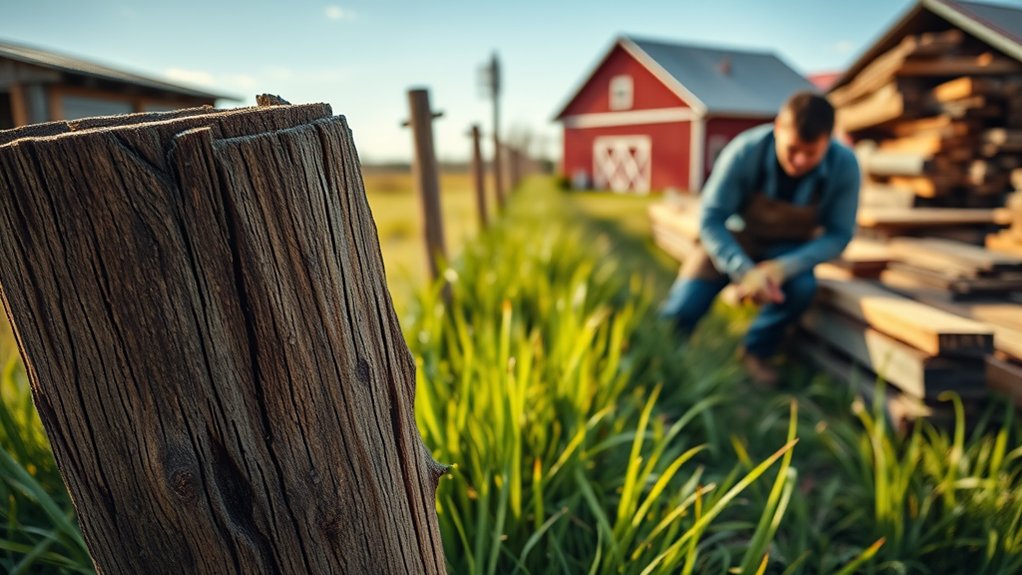
To repair wooden fences effectively, first check for loose panels and unstable posts. Replace any damaged panels and secure the posts to ensure stability. This straightforward approach helps prevent future problems and extends your fence’s lifespan. Additionally, using proper installation techniques during repairs can enhance the overall sturdiness of the fence.
Assessing Damage Properly
Evaluating damage to wooden fences is crucial for effective repairs. Start with a visual inspection of the entire fence, looking for loose boards, warped sections, and leaning posts. Check for rust or wear on the hardware.
Next, test the stability of the panels and posts by applying pressure. Look for signs of rot or insect damage, especially in areas prone to moisture.
Keep a detailed record of your findings, including photos and notes on the severity of the damage.
Prioritize structural repairs first, as these are vital for safety.
Finally, use weatherproofing techniques to help prevent future damage, ensuring your fence stays strong and functional.
Replacing Wooden Panels
Start by identifying which wooden panels need to be replaced to restore your fence’s strength. Clear any debris and check that the posts are stable before measuring the gaps between them.
Choose durable materials like treated wood for your new panels. If needed, cut the panels to size.
When installing, use screws or nails to secure the panels, ensuring they’re level and firmly in place. This will help prevent any future movement that might weaken the fence.
Lastly, consider applying a weatherproof sealant and set up a maintenance routine to extend the life of your fence. With proper care, it will stand strong against the elements.
Securing Fence Stability
After replacing damaged wooden panels, it’s time to secure your fence’s stability. Here are some straightforward steps:
- Post Reinforcement: Use metal menders and concrete to stabilize any leaning posts.
- Drainage Solutions: Add gravel around the posts to prevent soil erosion and ensure proper drainage.
- Curing Concrete: Allow the concrete to cure properly for lasting strength against the weather. Additionally, ensure the recommended post depth is adhered to for enhanced stability.
Regularly inspect your fence and budget for maintenance.
Address any signs of rot or erosion quickly to avoid bigger issues.
Fixing Vinyl Fences

When you see damage on your vinyl fence, it’s important to act quickly to avoid bigger problems and keep your property looking good. Start by assessing the damage and marking the areas that need repair. Grab your vinyl fence repair kit, which should include PVC primer and glue, to remove the damaged sections.
| Task | Description |
|---|---|
| Identify Damaged Parts | Find and mark areas for removal |
| Secure the Panels | Use brackets or screws for stability |
| Realign Panels | Adjust panels for proper alignment |
| Inspect for Leaks | Look for gaps or weak spots |
| Apply Protective Coatings | Use sealants to prevent future issues |
Additionally, remember that vinyl fences are virtually maintenance-free, which can save you time and effort in the long run. Lastly, inspect your repairs to ensure everything is secure and make a note of any ongoing maintenance needed.
Restoring Metal Fences
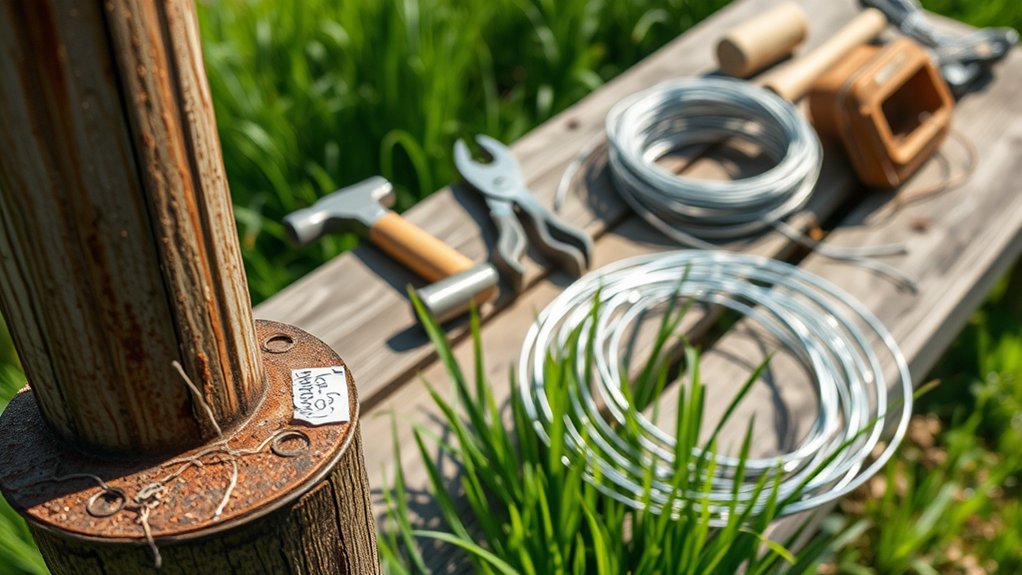
Metal fences are strong but can develop issues like rust and instability over time. To restore them effectively, follow these simple steps:
- Check for Damage: Look for rust or bent posts.
- Clean and Paint: Scrub with a wire brush and apply rust-resistant paint to protect against future damage.
- Secure Posts: If any posts have shifted, stabilize them with concrete or brackets.
If a post is beyond repair, replace it. For wire fences, find gaps, cut out the damaged sections, and patch them securely.
Tighten the mesh to keep it strong. By tackling these tasks, you ensure your metal fence remains sturdy and visually appealing for years to come.
Implementing Preventative Measures

To keep your farm fence in good shape, taking preventive steps is crucial. Start with sturdy materials like treated wood or metal that can withstand the elements.
Regularly clean the fence to remove debris and check for signs of wear. Every 2–3 years, apply weather-resistant sealants to wooden fences to protect against moisture and UV damage.
Control nearby vegetation to prevent it from trapping moisture against the fence. Regularly inspect the fence and fix any issues right away.
Strengthen weak posts and keep a record of your maintenance efforts. By following these simple strategies, you can extend the life of your fence and minimize future repairs.
Seasonal Maintenance Tips

As seasons change, regular inspections and maintenance of your farm fence are crucial for its longevity.
Here are three essential tasks to tackle each season:
- Spring: Look for winter damage and clear away any debris.
- Summer: Manage vegetation by trimming overgrowth and checking for pests.
- Autumn: Tighten loose parts and cut back branches that may harm the fence.
Make sure to remove organic debris from the fence line to avoid moisture buildup, and keep a clear zone by managing vegetation within 12 inches.
Documenting Repairs for Insurance
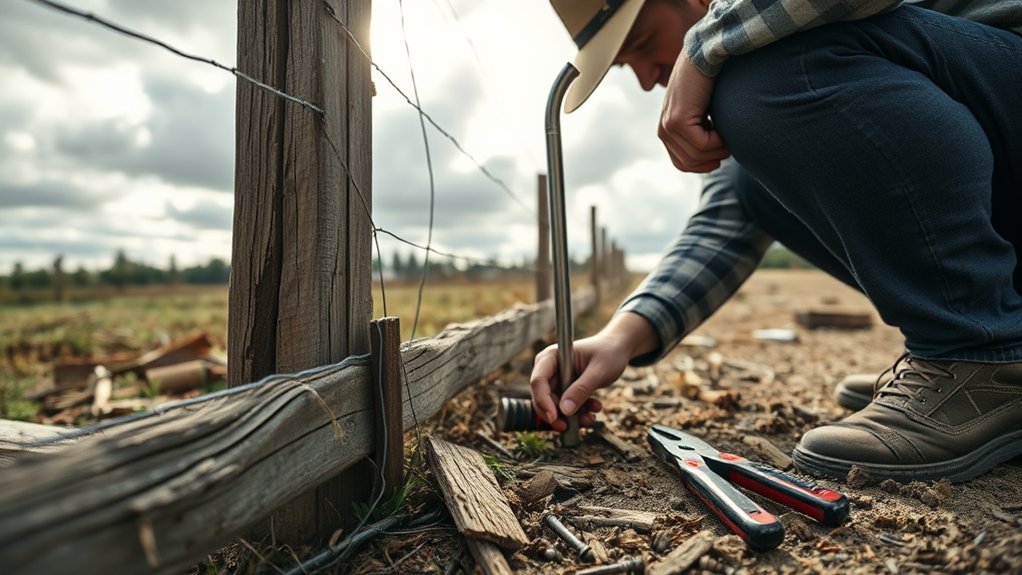
Documenting repairs for insurance claims is crucial to getting compensation for damaged farm fences. Start by carefully inspecting the damage and noting any visible or structural issues.
Take clear photos of the damaged areas from different angles, and make sure to record the date and cause of the damage if you know it. Write a brief report summarizing what you found.
Keep any receipts for materials you’ve used in the past, and if applicable, save police or incident reports.
When filling out your insurance claim forms, include your policy number, the date of the incident, and attach all your documentation.
Schedule a visit from an adjuster soon after your claim is submitted, and be prepared to present your materials. Clearly explain the damage to help ensure a fair evaluation and claims process.
Frequently Asked Questions
How Long Does It Typically Take to Repair a Fence?
Repair times for a fence depend on the damage and materials involved. For example, fixing a few loose boards might take just a couple of hours, while replacing a section of a wooden fence could take a few days. Weather can also play a role in delays, so it’s good to check conditions before starting any repairs.
What Are the Signs of Fence Damage to Look For?
About 50% of fences become unstable from weather damage. Watch for leaning posts, broken panels, large cracks, or rusted hardware. These signs mean your fence is weakened and needs immediate repairs.
Can I Repair My Fence Without Professional Help?
Yes, you can repair your fence on your own with just a few tools and some basic skills. Start by checking the damage carefully—look for broken boards or loose posts. Choose the right materials, like wood or vinyl, depending on your fence type. Make sure to stabilize the structure properly. With these steps, you can achieve solid, lasting repairs without needing a pro.
How Do I Choose the Right Materials for My Fence Repair?
When selecting materials for fence repair, think about options like pressure-treated pine for budget-friendliness or composite boards for their strength. Make sure to consider how well the materials will hold up in your local climate to ensure they last long and require little upkeep.
What Should I Do if My Fence Is Beyond Repair?
If your fence is beyond repair, think about replacing it with materials like cedar or bamboo. Weigh the costs, including how long the materials will last and installation fees, to ensure you make a smart investment for your property.
Conclusion
Once you’ve assessed the damage and gathered your tools, it’s time to make those repairs. Before you start, consider the potential for future weather issues. Implement preventative measures, like using weather-resistant materials and regular maintenance, to protect your hard work. Remember to document your repairs for insurance claims. Finally, take a moment to appreciate your sturdy, restored fence, ready to withstand whatever nature throws at it.


